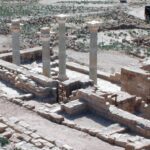In the Hellenistic Period, spanning from 323 BC to 32 BC, scant inscriptions shed light on the Nabataean merchants in the Hellenistic world. While references, such as those from Miletus in Asia Minor, date back to the 3rd century BC, a significant shift in Nabataean lifestyle unfolded during the 2nd century BC. These inscriptions predominantly highlight the nomadic aspect of Nabataean life rather than their sedentary pursuits.
The process of sedentarisation among the Nabataeans, particularly within the royal family and nobility, commenced with the selection of Petra as the tribe’s seat. Notably, this shift did not signify urbanisation but rather the representation of the upper class, as observed by scholar Robert Wenning.
Luxury was not compromised despite their tent-dwelling existence. A royal court flourished in Petra, earning it the distinction of being the capital of the Nabataeans in the Greek world. Wenning emphasized that living in tents did not preclude opulence, positioning Petra as the political and religious nucleus of the Nabataean realm.
The transition from nomadism to sedentarism did not escape notice on the international stage. In 129 BC, the city of Priene in Asia Minor dispatched an embassy to Petra, marking a diplomatic interaction. Even Chinese sources allude to Petra in 126 BC, underscoring its emerging significance.
Central to this transformation was the deity Dushara, the regional and local god who evolved into the tribe’s patron, overseeing numerous clans and the Nabataean dynasty. While debates persist about Dushara’s connection to the mountains of Edom or his role as a wilderness deity, his prominence in Petra was undeniable.
Petra’s ascent as the political and religious hub materialized in the second half of the 2nd century BC, coinciding with increased archaeological evidence. This period witnessed the flourishing of Nabataean pottery and coinage, indicative of a burgeoning population and social hierarchy.
The significance of Petra extended beyond cultural developments. The Nabataeans’ territorial conflicts with the Hasmonaeans, particularly east of the Dead Sea and the Jordan River, were rooted in Petra’s growing influence. The tribe had settled in Petra before 96 BC, as evidenced by the earliest dated Nabataean inscription in the Bab as-Siq sanctuary.
Wenning emphasized that Petra’s rock-cut structures, including triclinia, cultic cellae, and tombs, emerged decades prior to the oldest dated inscription. This period also marked the inception of Nabataean art, characterized by a direct yet simplified imitation of Hellenistic prototypes, as seen in their coins and pottery.








